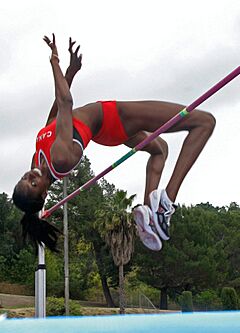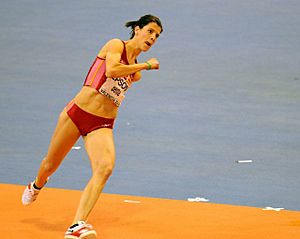High jump facts for kids
Quick facts for kids AthleticsHigh jump |
|
|---|---|

Canadian high jumper Nicole Forrester demonstrating the Fosbury flop
|
|
| World records | |
| Men | |
| Women | |
| Olympic records | |
| Men | |
| Women | |
| World Championship records | |
| Men | |
| Women | |
The high jump is an exciting track and field event. Athletes jump over a horizontal bar without knocking it down. Today, a bar is set between two poles, and jumpers land on a soft mat. Over time, jumpers found better ways to clear the bar. The most popular method now is the Fosbury Flop. In this style, athletes run towards the bar and leap head first with their back to the bar.
This event is one of two vertical jumping sports in the Olympic athletics program. The other is the pole vault. You can also see high jump at the World Championships in Athletics and other track and field meets. Women have competed in the high jump at the Olympics since 1928.
Javier Sotomayor from Cuba holds the men's world record. He jumped 2.45 m (8 ft 0.33169292 in) in 1993. This is the longest-standing record in men's high jump history. Yaroslava Mahuchikh from Ukraine holds the women's world record. She jumped 2.10 m (6 ft 10.55216536 in) in 2024.
| Top - 0-9 A B C D E F G H I J K L M N O P Q R S T U V W X Y Z |
High Jump Rules: How to Play
The rules for high jump are set by World Athletics. Jumpers must take off using only one foot. A jump is a failure if the athlete knocks the bar off. It's also a failure if they touch the ground or anything behind the bar before clearing it.
Athletes can start jumping at any height the judge announces. They can also choose to skip a height if they want. In most competitions, if a jumper misses three jumps in a row, they are out. This can happen at any height. The winner is the jumper who clears the highest bar.
What Happens in a Tie?
If two or more jumpers clear the same highest height, there are ways to break the tie. First, they look at who had the fewest misses at that final height. If it's still a tie, they look at who had the fewest misses throughout the whole competition.
If first place is still tied, the jumpers might have a "jump-off." They start at the next height above their best jump. Each jumper gets one try at each height. If only one succeeds, they win. If more than one succeeds, the bar goes up. If no one succeeds, the bar goes down. This continues until only one jumper wins.
However, a rule change in 2009 made jump-offs optional. Athletes who are tied for first place can agree to share the gold medal. This happened at the 2020 Olympic men's event in 2021.
High Jump History: How It Changed

The first recorded high jump event was in Scotland in the 1800s. Early jumpers used simple methods. Some ran straight at the bar. Others used a scissors technique. This involved throwing one leg and then the other over the bar.
Around the early 1900s, new techniques appeared. Michael Sweeney developed the Eastern cut-off. He took off like in the scissors method but flattened his body over the bar. He set a world record of 1.97 m (6 ft 5.43405512 in) in 1895. Even in 1948, John Winter won an Olympic gold medal using this style.
George Horine developed the Western roll. In this style, jumpers approached the bar at an angle. They used their inner leg to take off. Then they threw their outer leg up to lead their body sideways over the bar. Horine set a world record of 2.01 m (6 ft 7.00885827 in) in 1912. This technique was popular until the 1930s.
American and Soviet jumpers then developed the straddle technique. Straddle jumpers took off like in the Western roll. But they rotated their body, belly-down, around the bar. This was the most effective way to clear the bar at the time. Charles Dumas was the first to clear 7 feet (2.13m) in 1956. Valeriy Brumel from the Soviet Union dominated in the early 1960s. He set the record at 2.28 m (7 ft 5.63877953 in) and won the 1964 Tokyo Olympics.

Then came Dick Fosbury. He used the new, softer landing mats to try something different. Fosbury went over the bar head and shoulders first, landing on his back. This new style was called the Fosbury flop. Around the same time, Debbie Brill also came up with a similar technique.
Fosbury won the gold medal at the 1968 Mexico Olympics using his flop style. After that, the Fosbury Flop quickly became the most popular technique. The first flopper to set a world record was Dwight Stones in 1973. He cleared 2.30 m (7 ft 6.42618111 in). For women, Ulrike Meyfarth won the 1972 Olympics with the flop. She tied the women's world record at 1.92 m (6 ft 3.46555119 in).
Even with the flop's success, the straddle technique didn't disappear right away. In 1977, Vladimir Yashchenko set a new world record of 2.33 m (7 ft 7.60728347 in) using the straddle. He later raised it to 2.35 m (7 ft 8.39468504 in) indoors. Rosemarie Ackermann was the first woman to clear 2 m (6 ft 6.61515748 in) using the straddle. She held the women's world record until 1978.
However, the flop soon took over completely. In 1980, Jacek Wszoła broke Yashchenko's record with a flop jump of 2.35 m (7 ft 8.39468504 in). Sara Simeoni broke Ackermann's women's record with a flop jump of 2.01 m (6 ft 7.00885827 in). She also won the 1980 Olympics. Since then, almost all top high jumpers use the Fosbury Flop. Other techniques are rarely seen in major competitions.
High Jump Technique: How Athletes Jump
The way athletes jump has changed a lot over time. The Fosbury Flop is now seen as the best way to get over the bar.
The Approach Run

For the Fosbury Flop, athletes start on either the right or left side of the mat. They usually take an eight to ten-step run. The first few steps are straight, and the last five steps are on a curve. Athletes often mark their steps to make sure their run is consistent.
The approach run is very important. If a jumper's timing is off, or they don't run fast enough, it's harder to clear the bar. The run needs the right curve, speed, and number of steps. The angle of approach is also key for jumping high.
The straight part of the run builds speed. The athlete pushes off their takeoff foot with strong steps. They then speed up and should be running upright by the end of the straight part.
As they start the curve, their takeoff foot lands. They keep speeding up, aiming their body towards the opposite back corner of the mat. They stay upright and lean away from the mat. For their last two steps, they roll from heel to toe.
The "J" approach, used by Fosbury floppers, helps with speed. It also helps the athlete turn in the air and get into a good takeoff position. This helps change their forward speed into upward motion. The approach should be a strong, controlled run. Athletes should lean into the curve from their ankles, not their hips. This helps their hips rotate during takeoff. It also allows their center of gravity to pass under the bar.
The Takeoff
The takeoff can use one arm or two arms. The foot farthest from the bar should be planted. It should be angled towards the opposite back corner of the mat. At the same time, the athlete drives up the knee of their other leg. They also swing one or both arms.
Unlike the straddle technique, floppers adjust their takeoff spot as the bar gets higher. They move slightly farther away from the bar. Jumpers sometimes fail if too much energy goes into jumping up. This can make them knock the bar off with their legs as they go over.
The Flight Over the Bar
The knee of the athlete's non-takeoff leg naturally turns their body. This puts them in the air with their back to the bar. The athlete then pushes their shoulders towards their feet. This makes their body arch over the bar. They can look over their shoulder to know when to kick both feet over their head. This helps their body clear the bar and land safely on the mat.
Top High Jumpers: Most Medals
Here are some athletes who have won many titles at the Olympics and World Championships:
- 4 wins: Mariya Lasitskene (RUS) - Olympic Champion in 2020, World Champion in 2015, 2017 & 2019
- 4 wins: Mutaz Essa Barshim (QAT) - Olympic Champion in 2020, World Champion in 2017, 2019 & 2022
- 3 wins: Javier Sotomayor (CUB) - Olympic Champion in 1992, World Champion in 1993 & 1997
- 3 wins: Stefka Kostadinova (BUL) - Olympic Champion in 1996, World Champion in 1987 & 1995
- 2 wins: Gennadiy Avdeyenko (URS) - Olympic Champion in 1988, World Champion in 1983
- 2 wins: Charles Austin (USA) - Olympic Champion in 1996, World Champion in 1991
- 2 wins: Iolanda Balaș (ROU) - Olympic Champion in 1960 & 1964
- 2 wins: Ulrike Meyfarth (FRG) - Olympic Champion in 1972 & 1984
- 2 wins: Heike Henkel (GER) - Olympic Champion in 1992, World Champion in 1991
- 2 wins: Hestrie Cloete (RSA) - World Champion in 2001 & 2003
- 2 wins: Blanka Vlašić (CRO) - World Champion in 2007 & 2009
- 2 wins: Anna Chicherova (RUS) - Olympic Champion in 2012, World Champion in 2011
- 2 wins: Gianmarco Tamberi (ITA) - Olympic Champion in 2020, World Champion in 2023
Kostadinova and Sotomayor are the only high jumpers to have won an Olympic gold, a World Championship, and broken the world record.
Images for kids
Related pages
See also
 In Spanish: Salto de altura para niños
In Spanish: Salto de altura para niños



